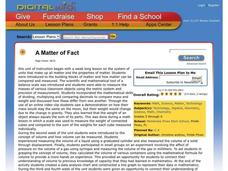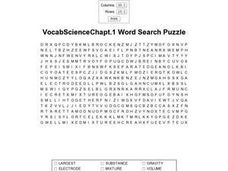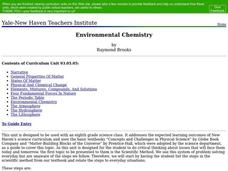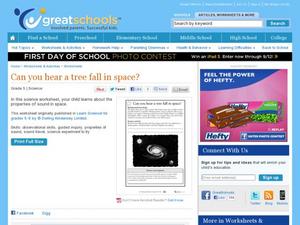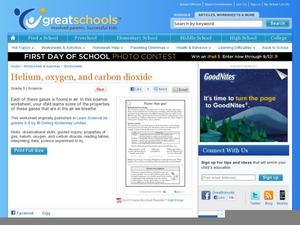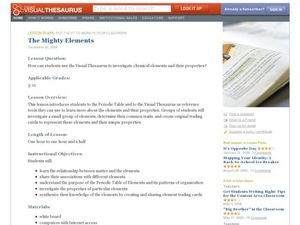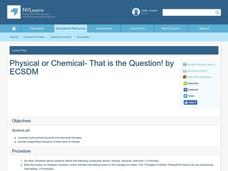Curated OER
Experimenting with Physical Changes
Fourth graders explore physical changes. They discuss that physical change is a change in size, shape, or state of matter of a substance. Students explore what change takes place when two substances can dissolve each other. They observe...
Curated OER
Water and Ice
Students examine water. In this chemistry lesson, student examine the physical properties of water and how it changes from a liquid to a solid or a gas. This lesson contains links to a second and third complimentary lesson on...
Curated OER
Water and Ice: Part 1
Learners observe the state changes in water. In this matter lesson, students observe, measure, and describe water as it changes state. Learners explore how water can change from a solid to a liquid then back again. They journal their...
Curated OER
A Matter of Fact
Students design their own Science experiment. In this science experiment lesson students create a hypothesis related to matter and test it. They displayed their data in a graph.
Curated OER
Water and Ice
Students explore the physical properties of water. In this water instructional activity, students observe, measure, and describe water as it changes state. There are 2 extensions for this instructional activity that one can access...
Curated OER
Physical/Chemical Properties of a Burning Candle
Students investigate the physical and chemical properties of a candle before and after it is lit. They conduct a burning candle experiment, and complete a KWL chart and worksheet, recording the results of the investigation.
Curated OER
Vocab Science Chapter 1
In this word search worksheet, students locate 20 words related to science. The word list includes volume, mixture, and solute.
Curated OER
The Science of Weather: Hurricanes
Students use this USA today activity to learn about hurricane season. In this hurricane lesson plan, students study the map of the earth and hurricane science. Students complete discuss questions. Students draw a map of the United States...
Curated OER
Environmental Chemistry
Eighth graders are introduced to the topic of Environmental Chemistry. In groups, they review the steps within the scientific method and develop their own hypothesis and design an experiment. They solve equations related to the...
Curated OER
Melting, Freezing, and More!: Phase Transitions
Third graders listen to a talk on phase transitions and view three demonstrations. In this phases of matter lesson, 3rd graders complete a worksheet as they listen about phase transitions. They move through three demonstrations of phase...
National Institute of Open Schooling
The Liquid State
Due to surface tension, dew — a liquid, is spherical in shape. Learners explore the properties of liquids in activity seven in this series of 36. Beginning with its basic properties such as boiling point and moving through to surface...
It's About Time
Elements and Compounds
Young scientists use electrolysis to separate water into its elements before experimenting with fire to learn about their properties. A helpful resource provides a reading passage and analysis questions.
It's About Time
Polymers
All plastics contain polymers, but not all polymers are plastic. Young chemists make their own polymer and compare the properties to those of other states of matter. After a reading passage, pupils answer analysis questions about natural...
Curated OER
Can You Hear a Tree Fall in Space?
How does sound travel in space? Fifth graders investigate this question with a science activity, in which they research the properties of sound. Schedule a lab visit for individual Internet research, or include the activity after you...
Curated OER
Polymers all Over the Place
Young scholars investigate properties of common molecules. In this chemistry activity, students construct polymer models to gain a better understanding of the properties of polymers.
Curated OER
Name That Gas!
Young scientists discover that air is a mixture of different gases - mainly nitrogen and oxygen. The properties of some of the other gases found in oxygen are listed in a table, then learners must decide which one of those gases is...
Virginia Department of Education
Soap, Slime, and Creative Chromatography
Do you think chromatography paper suffers from separation anxiety? Young chemists make soap, slime, silly putty, and experiment with chromatography in this lesson. The material includes clear instructions for each experiment along with...
National Institute of Open Schooling
Colloids
Classes explore colloids through readings and questions in lesson 10 in a series of 36. They learn everything from methods of preparation and properties to how to classify colloids. They finish the lesson by seeing how to apply...
Curated OER
Magnet Circus
Students explore the properties of magnets by designing a device that can move as far as possible using only magnets to move it, and design a machine that will stay in motion for the greatest period of time.
Curated OER
Inquiry into Consumer Products
Students recognize different consumer products, found in and around the home, that have reactive or denaturing properties when used together. They explore chemical and physical properties of each product by identifying chemical formulas...
Curated OER
The Mighty Elements: Using the Visual Thesaurus to Investigate Chemical Elements
Pupils create trading cards for elements in the Periodic Table. Initially, they are introduced to the Periodic Table of Elements and the concept of elements in the world around us. After dividing into groups, learners use the Visual...
Aquarium of the Pacific
Lego Molecules
Young scientists construct an understanding of molecular compounds in this hands-on science lesson. Using LEGO® to model the atoms of different elements, students build molecules based on the chemical formulas of common compounds.
PHET
Earth’s Magnetic Field from Space
Feel the pull of science! The final installment of this 18-part series is an application of everything learned in the previous high school lessons. Scholars are given a magnetic field map and must propose an arrangement of magnets that...
Curated OER
Physical or Chemical- That is the Question!
Students observe the differences between physical and chemical changes in properties. Through the use of an interactive presentation, the students compare and contrast the changes and provide supporting examples of each type of change.





